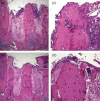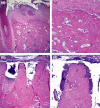Experimental development of bisphosphonate-related osteonecrosis of the jaws in rodents
- PMID: 23317355
- PMCID: PMC3575875
- DOI: 10.1111/iep.12007
Experimental development of bisphosphonate-related osteonecrosis of the jaws in rodents
Abstract
Osteonecrosis of the jaw (ONJ) following the use of bisphosphonates has become of increased interest in the scientific community, due in particular to its as-yet-unsolved pathogenesis. An experimental model of ONJ was induced in normal male rats [alendronate (ALN); 1 mg/Kg/day; n = 10] and matched controls (saline solution; n = 10). After 60 days of drug treatment, all animals were subjected to extractions of the left first lower molars and were euthanized at 3 and 28 days postsurgery. The following analyses were performed: (i) descriptive and quantitative (scores) histological evaluation, (ii) stereometry of distal sockets and (iii) biochemical measurement of C-telopeptide cross-linked collagen type I (CTX) and bone-specific alkaline phosphatase (BALP). The results showed that 28 days postsurgery the animals treated with ALN had areas of exposed and necrotic bone, associated with significant infection, especially in the interalveolar septum area and crestal regions, compared with controls. The levels of CTX, BALP and bone volume, as well as the degrees of inflammation and vascularization, were significantly reduced in these animals. Therefore, analysis of the data presented suggests that ALN therapy is associated with the development of osteonecrosis in the jaws of rodents after tooth extraction.
© 2012 The Authors. International Journal of Experimental Pathology © 2012 International Journal of Experimental Pathology.
Figures









Similar articles
-
Experimental osteonecrosis: development of a model in rodents administered alendronate.Braz Oral Res. 2016 Aug 22;30(1):e99. doi: 10.1590/1807-3107BOR-2016.vol30.0099. Braz Oral Res. 2016. PMID: 27556684
-
Bisphosphonate-induced osteonecrosis of the jaw in a rat model arises first after the bone has become exposed. No primary necrosis in unexposed bone.J Oral Pathol Med. 2012 Jul;41(6):494-9. doi: 10.1111/j.1600-0714.2011.01125.x. Epub 2012 Jan 23. J Oral Pathol Med. 2012. PMID: 22268631
-
Experimental investigation of relationship between trauma and bisphosphonate-related osteonecrosis.Niger J Clin Pract. 2014 Sep-Oct;17(5):559-64. doi: 10.4103/1119-3077.141417. Niger J Clin Pract. 2014. PMID: 25244263
-
Dental extraction as a risk factor for bisphosphonate related osteonecrosis of the jaw in cancer patients: an update.Odontostomatol Trop. 2013 Jun;36(142):38-46. Odontostomatol Trop. 2013. PMID: 24073539 Review.
-
Osteonecrosis of the Jaw-a Bone Site-Specific Effect of Bisphosphonates.Curr Osteoporos Rep. 2016 Oct;14(5):219-25. doi: 10.1007/s11914-016-0318-z. Curr Osteoporos Rep. 2016. PMID: 27474028 Review.
Cited by
-
Summary of the various treatments for osteonecrosis of the femoral head by mechanism: A review.Exp Ther Med. 2014 Sep;8(3):700-706. doi: 10.3892/etm.2014.1811. Epub 2014 Jun 26. Exp Ther Med. 2014. PMID: 25120585 Free PMC article.
-
Delayed alveolar bone repair and osteonecrosis associated with Zoledronic Acid therapy in rats: macroscopic, microscopic and molecular analysis.J Appl Oral Sci. 2020 Sep 25;28:e20200204. doi: 10.1590/1678-7757-2020-0204. eCollection 2020. J Appl Oral Sci. 2020. PMID: 32997086 Free PMC article.
-
Strontium ranelate improves post-extraction socket healing in rats submitted to the administration of bisphosphonates.Odontology. 2022 Jul;110(3):467-475. doi: 10.1007/s10266-021-00678-1. Epub 2022 Jan 18. Odontology. 2022. PMID: 35041107
-
Rodents as an animal model for studying tooth extraction-related medication-related osteonecrosis of the jaw: assessment of outcomes.Arch Oral Biol. 2024 Mar;159:105875. doi: 10.1016/j.archoralbio.2023.105875. Epub 2023 Dec 26. Arch Oral Biol. 2024. PMID: 38160519 Free PMC article. Review.
-
Role of Periapical Diseases in Medication-Related Osteonecrosis of the Jaws.Biomed Res Int. 2017;2017:1560175. doi: 10.1155/2017/1560175. Epub 2017 Oct 4. Biomed Res Int. 2017. PMID: 29109954 Free PMC article.
References
-
- Aguirre JI, Altman MK, Vanegas SM, Franz SE, Bassit AC, Wronski TJ. Effects of alendronate on bone healing after tooth extraction in rats. Oral Dis. 2010;16:674–685. - PubMed
-
- Allen MR, Follet H, Khurana M, Sato M, Burr DB. Antiremodeling agents influence osteoblast activity differently in modeling and remodeling sites of canine rib. Calcif. Tissue Int. 2006;79:255–261. - PubMed
MeSH terms
Substances
LinkOut - more resources
Full Text Sources
Other Literature Sources

